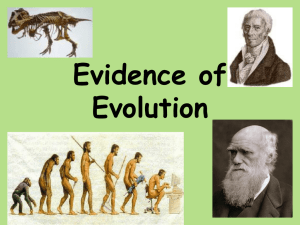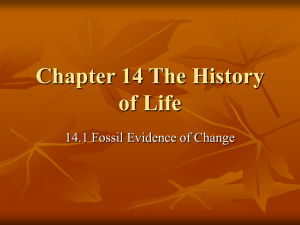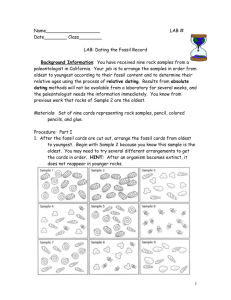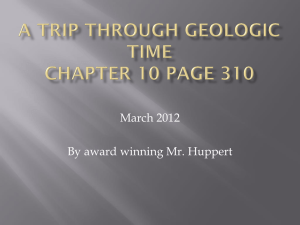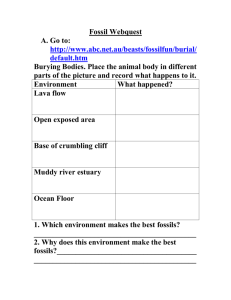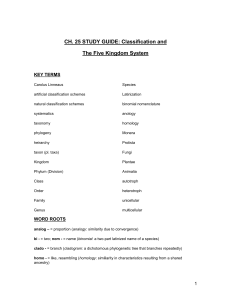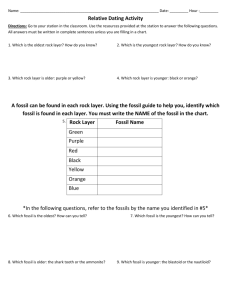Virtual Lab: Dinosaur Dig
advertisement
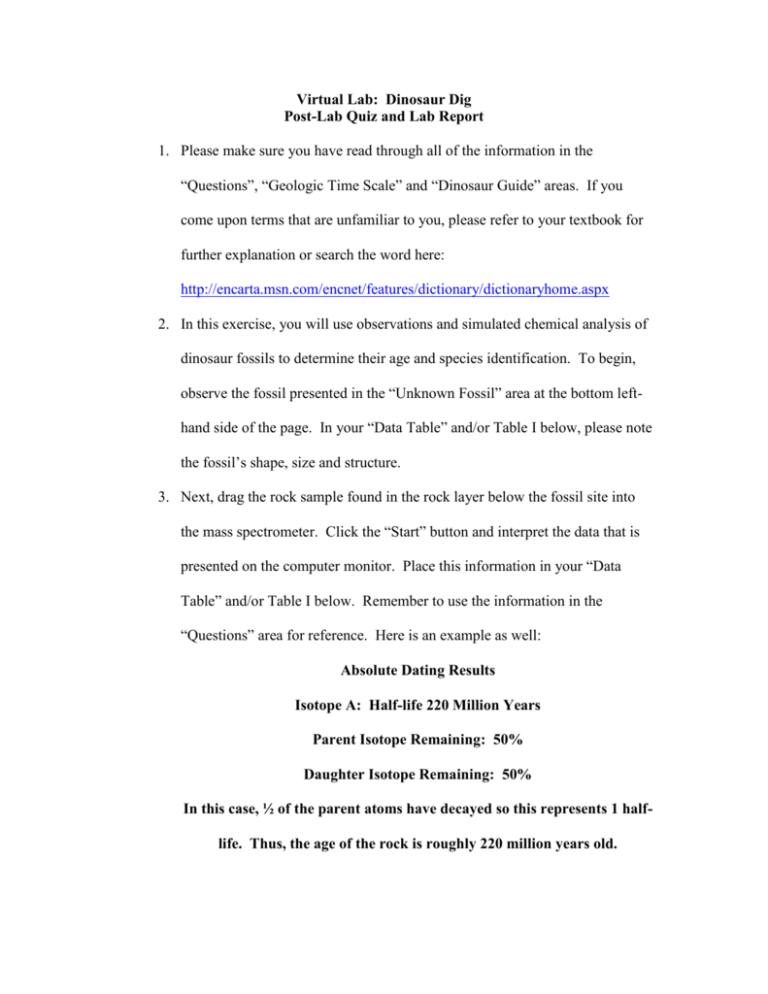
Virtual Lab: Dinosaur Dig Post-Lab Quiz and Lab Report 1. Please make sure you have read through all of the information in the “Questions”, “Geologic Time Scale” and “Dinosaur Guide” areas. If you come upon terms that are unfamiliar to you, please refer to your textbook for further explanation or search the word here: http://encarta.msn.com/encnet/features/dictionary/dictionaryhome.aspx 2. In this exercise, you will use observations and simulated chemical analysis of dinosaur fossils to determine their age and species identification. To begin, observe the fossil presented in the “Unknown Fossil” area at the bottom lefthand side of the page. In your “Data Table” and/or Table I below, please note the fossil’s shape, size and structure. 3. Next, drag the rock sample found in the rock layer below the fossil site into the mass spectrometer. Click the “Start” button and interpret the data that is presented on the computer monitor. Place this information in your “Data Table” and/or Table I below. Remember to use the information in the “Questions” area for reference. Here is an example as well: Absolute Dating Results Isotope A: Half-life 220 Million Years Parent Isotope Remaining: 50% Daughter Isotope Remaining: 50% In this case, ½ of the parent atoms have decayed so this represents 1 halflife. Thus, the age of the rock is roughly 220 million years old. 4. Repeat step number 3 for the rock sample found in the rock layer above the fossil site. 5. Next, open the “Geologic Time Scale” and use the absolute dating results to determine the period in which this dinosaur existed. Input this information into your “Data Table” and/or Table I below. 6. To complete your analysis of the fossil, compare the data you have obtained with the reference information listed in the “Dinosaur Guide” to determine the species identification of the fossil. Place this information in your “Data Table” and/or Table I. Note: There are extra rows in your table to identify additional fossils if necessary. Click the “reset” button to call up a new fossil specimen to identify. 7. Please finish this exercise by opening the “Journal” link at the bottom of the page and answering the questions. Table I: Fossil Information Absolute Dating of Rock Layer Below Absolute Dating of Rock Layer Above Geologic Time Period Dinosaur Species Post-laboratory Questions: 1. Based upon evidence, it appears that a mass extinction of reptile species occurred during which era? a. Precambrian b. Paleozoic c. Cenozoic d. All of the above 2. One of the earliest known dinosaurs was: a. Stegosaurus b. Tyrannosaurus rex c. Coelophysis d. Diplodocus 3. The fossil of which species brought forth the idea of modern day birds potentially being descended from dinosaurs? a. Stegosaurus b. Diplodocus c. Tyrannosaurus rex d. Archaeopteryx 4. The fossils of Archaeopteryx appear so well-preserved due to the fact that they were found in what was once: a. a dry desert b. cold arctic ice c. a lagoon d. a low oxygen environment e. c and d 5. Based on fossil evidence, peg-like blunt teeth in the front of the jaw appeared best suited for which type of lifestyle? a. Scavenger b. Carnivore c. Predator d. Herbivore 6. Based on fossil evidence, which species appeared to have hollow bones? a. Diplodocus b. Coelophysis c. Archaeopteryx d. Tyrannosaurus rex e. C and D f. None of the above 7. Dinosaurs: a. Appear to have evolved from archosaurs b. Were predominant in the Paleozoic era c. Became extinct in the Cenozoic era d. All of the above 8. Mammals: a. Coexisted for a time with dinosaurs b. Became predominant in the Tertiary period c. Were first seen in the Cambrian period d. A and B e. None of the above 9. Archaeologists tend to find fossils most often embedded in which type of rock? a. Sedimentary b. Igneous c. Metamorphic 10. Absolute dating is best performed on rocks formed: a. in a cold region b. near a hydrothermal vent below the ocean’s surface c. near a volcano d. B and C e. all of the above


